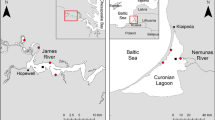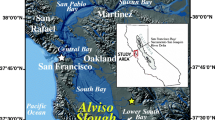Abstract
Measurements of suspended matter, particulate organic carbon and dissolved organic carbon were made over a three year period at stations spanning 150 km of the tidal freshwater Hudson River. Suspended matter concentrations varied from year-to-year and were not related to freshwater discharge. The increase in suspended matter with depth in vertical profiles suggests that, during medium to low flow conditions, resuspension of bottom sediments was as important a source of sediment as loadings from tributaries. Particulate organic carbon showed significant variability among stations, and both autochthonous primary production and detrital organic matter are contributing to POC standing stocks. Dissolved organic carbon represented over half of the total organic carbon in the water column and showed little variation among stations.
Examining downstream changes in transport showed that there was significant production of both suspended matter and POC within the study reach during the ice-free season. Tributary loadings within the study reach do not appear to be the cause of these increases in downstream transport. Dissolved organic carbon behaved conservatively in that there was no evidence for net production or net consumption within the river.
The spatial/temporal patterns and analyses of transport suggest that suspended matter and POC, but not DOC, were controlled to a significant extent by processes occurring within the river and were not simply related to loadings from outside.
Similar content being viewed by others
References
Bianchi T & Findlay S (1991) Decomposition of Hudson River macrophytes: photosynthetic pigment transformations and decay constants. Estuaries 14: 65–73
Bokuniewicz H & Arnold CL (1984) Characteristics of suspended sediment transport in the lower Hudson River. Northeastern Environmental Science 3: 185–190
Caraco NF (1986) Phosphorous, iron and carbon cycling in a stratified coastal pond. Doctoral dissertation, Boston University Marine Program, Boston, Massachusetts
Coch NK & Bokuniewicz HJ (1986) Oceanographic and geologic framework of the Hudson system. Northeastern Geology 8: 96–108
Cole BE & Cloern JE (1987) An empirical model for estimating phytoplankton productivity in estuaries. Marine Ecolology Progress Series 36: 299–305
Cole BE & Cloern JE (1984) Significance of biomass and light availability to phytoplankton productivity in San Francisco Bay. Marine Ecology Progress Series 17: 15–24
Cole JJ, Caraco NF & Peierls B (1991) Phytoplankton primary production in the tidal, freshwater Hudson River, New York (USA). Verhandlungen der Internationalen Vereinigun für Theoretische und Angewandte Limnologie (in press)
Cooper JC, Cantelmo FR & Newton CE (1988) Overview of the Hudson River estuary. American Fisheries Society Monograph 4: 11–24
Dankers N & Laane R (1983) A comparison of wet oxidation an loss on ignition of organic material in suspended matter. Environmental Technology Letters 4: 283–290
Degens ET & Ittekkot V (1985) Particulate organic carbon: An overview. Mitteilungen aus dem Geologisch-Palaontologischen Instititut der Universität Hamburg, SCOPE-UNEP Sonderbd. 58: 7–27
Ellsworth JM (1986) Sources and sinks for fine-grained sediment in the lower Hudson River. Northeastern Geology 8: 141–155
Fox, LE, Sager SL and Wofsy SC (1986) The chemical control of soluble phosphorous in the Amazon estuary. Geochimica et Cosmochimica Acta 50: 783–794
Giese GL & Barr JW (1967) The Hudson River estuary: A preliminary investigation of flow and water quality characteristics. State of New York Conservation Department, Water Resources Commission Bulletin # 61
Gladden JB, Cantelmo FR, Croam JM & Shapot R (1988) Evaluation of the Hudson River ecosystem in relation to the dynamics of fish populations. American Fisheries Society Monograph 4: 37–52
Ittekkot V (1988) Global trends in the nature of organic matter river suspensions. Nature 332: 436–438
Koenings JP, Burkett RD & Edmundson J (1990) The exclusion of limn c cladocera from turbid glacier-meltwater lakes. Ecology 71: 57–67
Lewis WM & Saunders JF (1989) Concentration and transport of dissolved and suspended substances in the Orinoco River. Biogeochemistry 7: 203–240
Limburg KE, Moran MA & McDowell WH (1986) The Hudson River Ecosystem. Springer-Verlag, NY
Meade RH, Dunne T, Richey JE, Santos U & Salati E (1985) Storage and remobilization of suspended sediment in the lower Amazon River of Brazil. Science 228: 488–500
Meybeck M (1982) Carbon, nitrogen and phosphorous transport by world rivers. American Journal of Science 282: 401–450
Meyer JL, Edwards RT & Risley R (1987) Baterial growth on dissolved organic carbon from a blackwater river. Microbial Ecology 13: 13–29
Milliman JD & Meade RH (1983) World-wide delivery of river sediment to the oceans. Journal of Geology 91: 1–21
Moeller JR, Minshall GW, Gummins KW, Petersen RC, Cushing CE, Sedell JR, Larson RA & Vannote RL (1979) Transport of dissolved organic carbon in streams of differing physiographic characteristics. Organic Geochemistry 1: 139–150
Mulholland PJ & Watts JA (1982) Transport of organic carbon to the oceans by rivers of North America: a synthesis of existing data. Tellus 34: 176–186
Olsen CR, Larsen IL, Brewster RH, Cutshall NH, Bopp RF, Simpson HJ (1984) A geochemical assessment of sedimentation and contaminant distributions in the Hudson-Raritan Estuary. NOAA Technical Report NOS OMS 2, 101 pp
Parsons TR, Takahashi M & Hargrave B (1984) Biological oceanographic processes, 3rd edition. Pergamon Press, New York, NY
Postma H (1967) Sediment transport and sedimentation in the estuarine environment In: Lauff GH (Ed) Estuaries (pp 158–179). American Association for the Advancement of Science, Publication 83
Richards K (1982) Rivers: Form and Process in Alluvial Channels. Methuen, London and New York
Saunders JF & Lewis WM (1989) Zooplankton abundance in the lower Orinoco River, Vnezuela. Limnology and Oceanography 34: 397–409
Schlesinger WH & Melack JM (1981) Transport of organic carbon in the world's rivers. Tellus 33: 172–187
Schubel JR & Carter HH (1984) The estuary as a filter for fine-grained suspended sediment In: Kennedy VS (Ed) The Estuary as a Filter (pp 81–105). Academic Press
Smith RA, Alexander RB & Wolman MG (1987) Water-quality trends in the nation's rivers. Science 235: 1607–1615
Stuart V, Field J & Newell R (1982) Evidence for absorption of kelp detritus by the ribbed mussel Aulacomya ater using a new 51-Cr-labelled microsphere technique. Marine Ecology Progress Series 9: 263–271
Threlkeld ST (1986) Life table responses and population dynamics of four cladoceran zooplankton during a reservoir flood. Journal of Plankton Research 8: 639–647
Uncles RJ, Stephens JA & Woodrow TY (1988) Seasonal cycling of estuarine sediment and contaminant transport. Estuaries 11: 108–116
Wainwright SC (1987) Stimulation of heterotrophic microplankton production by resuspended marine sediments. Science 238: 1710–1712
Wershaw RL & Burcar PJ & Goldberg MC (1969) Interaction of pesticides with natural organic material. Environmental Science and Technology 3: 271–273
Whittaker RH & Likens GE (1973) Carbon in the biota. In: Woodwell G & Pecan E (Eds) Carbon and the Biosphere. United States Atomic Energy Comission (pp 281–302). Springfield, VA
Williams SC, Simpson HJ, Olsen CR & Bopp RF (1978) Sources of heavy metals in sediments of the Hudson River Estuary. Marine Chemistry 6: 195–213
Wofsy S (1983) A simple model to predict extinction coefficients and phytoplankton biomass in eutrophic waters. Limnology and Oceanography 28: 1144–1155
Author information
Authors and Affiliations
Rights and permissions
About this article
Cite this article
Findlay, S., Pace, M. & Lints, D. Variability and transport of suspended sediment, particulate and dissolved organic carbon in the tidal freshwater Hudson River. Biogeochemistry 12, 149–169 (1991). https://doi.org/10.1007/BF00002605
Accepted:
Issue Date:
DOI: https://doi.org/10.1007/BF00002605




